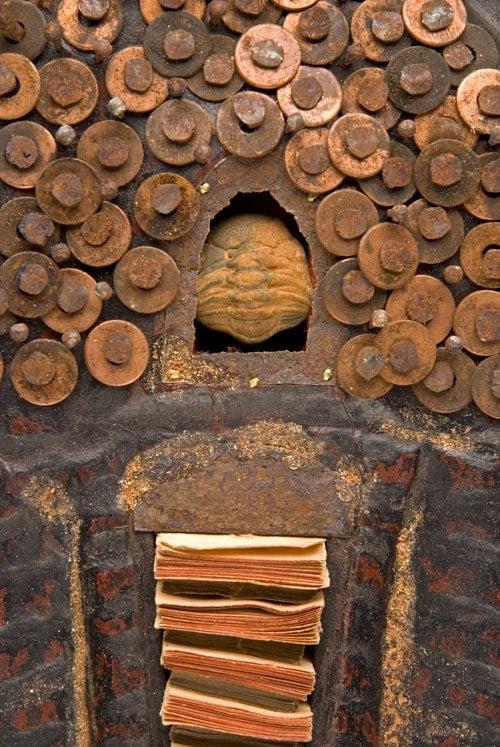
In her monograph The Century of Artists’ Books, Joanna Drucker traces several ways in which the artist’s book was established as its own unique art form in the 1960s and 1970s. In particular, she cites the founding of a handful of artist’s book presses as a critical event in the rise of book art. Atlanta’s own Nexus Press, which was in operation from 1976 to 2003, is described by Drucker as one of these foundational presses. The Atlanta Contemporary Art Center’s exhibition “Endless Road: A Look at Nexus Press,” curated by Daniel Fuller and on view through July 25, is intended to open a dialogue about this pioneering institution’s legacy, according to one of the wall texts.
This celebratory mode of presentation is apparent in the exhibition’s setup. Nearly every book produced by Nexus is available for individuals to pick up and read on several tables and stands. For those books that are too rare to be handled by viewers, projected video of a person flipping through the books provides another way to interact. A couple of billboards in the galleries are crowded with print ephemera, postcards, and flyers announcing classes and book releases. The choices are pleasurably overwhelming for viewers.

It is not possible to peruse each work of art, but one does notice recurring themes in the books Nexus Press chose to produce. Exquisitely printed books of photography were a mainstay of Nexus’s output. One of its earliest productions, Photographs by P.H. Polk (1980), is an essential book showcasing the work of this hugely important African-American photographer. Born in 1898 and educated at the Tuskeegee Institute in Alabama, Polk is recognized for his beautifully composed and honest portraits of African Americans in the rural South. Bill Burke’s notorious I Want to Take Picture (1987) and Mine Fields (1990), haunting and sometimes grisly photodocuments of the artist’s experiences traveling in post-Khmer Rouge Southeast Asia, are also featured. Travel emerges as a theme of many books in the collection, from Paul Trautwein’s Bangkok (1993) and India (1993) to Clarissa Sligh’s Voyage(r): A Tourist Map to Japan (2000). Sligh’s book, which is nestled inside a fabric bag, documents the artist’s trip to Japan and her struggles navigating the country as an African American woman.
Indeed, one sees how Nexus was an artistic and political vanguard in its aim to print books that discussed race, gender, and American history. Pat Courtney’s Per-sis-tent Ster-e-o-types (1988) reproduces dictionary definitions and illustrations that perpetuate stereotypes about women. Testify! (1985) by Marvin Rhodes offers candid and moving portraits of U.S. veterans. As I walked through the exhibition and eavesdropped on visitors’ conversations, many were excitedly discussing how a number of these books focus on issues that are still taboo or controversial.

If a goal of the exhibition is to foster a celebratory dialogue, the room filled with Nexus’s books certainly achieved this goal. What I found most puzzling was the exhibition room that contained the press’s administrative desk—virtually untouched since Nexus shut down operations in 2003—printing machinery (including a Robertson Photomechanix), and stacks of book boxes on top of wood pallets. The room nodded toward a desire to reproduce the staging of the press when it was in operation, but it did not commit fully to this idea. Nor was there much exploration of the press’s groundbreaking work in certain production methods. Nexus Press trailblazed in offset printing methods, but there is not much of an explanation as to what offset printing is, nor how Nexus’s methods changed the printing and bookmaking game in this regard. Moreover, now that the ACAC and Nexus Press’s papers will be housed in Emory University’s library, I found myself wishing for the show to present more of a challenge to its viewers in terms of asking them how presses or institutions such as Nexus persist after their deaths. What does it mean to have precious works of art collecting dust in storage rooms? How do we sort through the ephemera, garbage, and documents of an institution while also preserving its history and legacy? These are essential questions as Atlanta’s art scene grows and as the city discusses its artistic past, and they are questions I wish “Endless Road” asked more pointedly.
“Endless Road: A Look at Nexus Press” is on view at the Atlanta Contemporary Art Center through July 25.
Kate Doubler holds a doctorate in English Literature from Emory University. She is the founding curator of The Artists’ Books Showcase, has written extensively on book arts, and dabbles in letterpress and relief printing.





